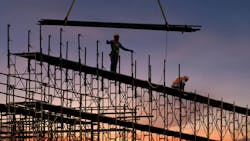29CFR 1926 Subpart M provides the requirements for fall protection. Section 1926.502 is the meat of Subpart M. It runs for several pages and covers 11 topics. Now we’ll look at the last two topics in this series:
- (j) Protection from falling objects
- (k) Fall protection plan
OSHA’s rules for protection from falling objects consists of eight enumerated requirements, five of which apply to electrical work. The first three are about toeboards. These have to be:
- Erected along the edge of the elevated surface.
- Capable of withstanding, without fail, a force of at least 50 lb applied in any downward direction.
- At least 3.5-in. tall (the same as a 2 × 4 standing on its narrow side), and either solid or having holes no more than 1-in. in any dimesion.
The other two are:
- If tools or other items are piled higher than the toeboards, you must provide an extension of the toeboard using paneling or screening.
- Guardrail systems (if used as falling object protection) must have openings too small for objects to pass through and fall onto people below. A simple fix if your guardrails don’t pass this test is to combine them with toeboards.
OSHA enumerates 1o rules for your fall protection plan. The first four requirements are about the qualifications of those managing the plan.
First of all, the plan must be developed by a qualified person and developed specifically for the site in question. Second, any changes to it must be approved by a qualified person. And (third) beacuse the plan is site specific, a copy of it with all approved changes must be maintained at the job site.
Fourthly, OSHA requires the implementation of the plan to be under the supervision of a “competent person.” Notice, the wording is not “qualified person.” What is a “competent person?” Subpart C General Safety and Health Provisions holds the answer, specifically in 1926.32 Definitions. Term (f) is “Competent person,” and the definition is “one who is capable of identifying existing and predictable hazards in the surroundings or working conditions which are unsanitary, hazardous, or dangerous to employees, and who has the authorization to take prompt corrective measures to eliminate them.”
That last part of the definition is where “competent” comes in. The first part of the definition conveys knowledge, which is another way of saying OSHA expects this person to be a qualified person — but simply knowing what’s wrong doesn’t mean you can fix it. This person also needs the power to act quickly.
Sometimes, a fall protection method would create a greater hazard or is just infeasible. The next four requirements (No. 5 through No. 8) deal with that. The reasons for not using conventional method must be documented, a written discussion of other methods taken must be included in the plan, the plan must identify each location where the conventional methods cannot be used, and where no alternative has been implemented, the employer shall implement a safety monitoring system per 1926.502(h).
The ninth requirement is the fall protection plan must provide the name (or other identification method) of each employee who is designated to work in the controlled access zones. No other employees may enter those zones.
The tenth and final requirement is triggered if an employee falls or there is some other related incident (including a near miss). In such a case, the employer must investigate the circumstances of the incident and determine if the fall protection plan needs to be updated. The employer subsequently must implement the change(s), such as new practices, procedures, or training to prevent similar incidents from occurring.
About the Author

Mark Lamendola
Mark is an expert in maintenance management, having racked up an impressive track record during his time working in the field. He also has extensive knowledge of, and practical expertise with, the National Electrical Code (NEC). Through his consulting business, he provides articles and training materials on electrical topics, specializing in making difficult subjects easy to understand and focusing on the practical aspects of electrical work.
Prior to starting his own business, Mark served as the Technical Editor on EC&M for six years, worked three years in nuclear maintenance, six years as a contract project engineer/project manager, three years as a systems engineer, and three years in plant maintenance management.
Mark earned an AAS degree from Rock Valley College, a BSEET from Columbia Pacific University, and an MBA from Lake Erie College. He’s also completed several related certifications over the years and even was formerly licensed as a Master Electrician. He is a Senior Member of the IEEE and past Chairman of the Kansas City Chapters of both the IEEE and the IEEE Computer Society. Mark also served as the program director for, a board member of, and webmaster of, the Midwest Chapter of the 7x24 Exchange. He has also held memberships with the following organizations: NETA, NFPA, International Association of Webmasters, and Institute of Certified Professional Managers.
